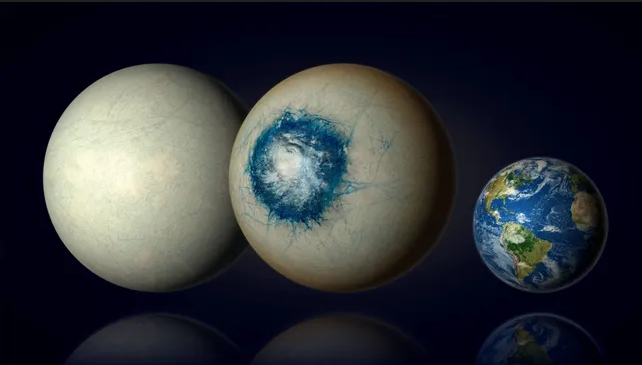In an exciting development for the search for extraterrestrial life, the James Webb Space Telescope (JWST) has made groundbreaking observations of a nearby exoplanet, LHS 1140 b. Located just 40 light-years away in the constellation Cetus, this exoplanet is now believed to possibly harbor an alien ocean beneath its icy surface, raising intriguing possibilities for life beyond Earth.

Temperate exoplanet LHS 1140 b may be a world completely covered in ice (left) similar to Jupiter’s moon Europa or be an ice world with a liquid substellar ocean and a cloudy atmosphere (centre). LHS 1140 b is 1.7 times the size of our planet Earth (right) and is the most promising habitable zone exoplanet yet in our search for liquid water beyond the Solar System. (Image credit: B. Gougeon/Université de Montréal)
Discovering LHS 1140 b
LHS 1140 b is a super-Earth, a type of exoplanet with a mass larger than Earth’s but smaller than that of Uranus or Neptune. Initially discovered in 2017, this rocky world orbits within the habitable zone of its star, where conditions could allow liquid water to exist. The JWST’s advanced observational capabilities have provided new insights into the planet’s atmosphere and surface conditions, suggesting the presence of water.
Key Findings by JWST
- Atmospheric Analysis: The JWST has detected signs of a dense atmosphere around LHS 1140 b, composed of water vapor and potentially other gases crucial for life. This atmosphere could indicate the presence of liquid water on or below the planet’s surface.
- Surface Conditions: Observations hint at an icy crust overlaying a subsurface ocean. This structure is similar to some of the moons in our solar system, such as Europa and Enceladus, which are also believed to harbor oceans beneath their icy exteriors.
- Potential for Life: The combination of a stable atmosphere and liquid water makes LHS 1140 b a prime candidate in the ongoing search for habitable exoplanets. These conditions are essential for life as we know it, making the exoplanet a focus of intense scientific interest.
Implications for Astrobiology
The discovery of a possible subsurface ocean on LHS 1140 b has significant implications for astrobiology. Oceans provide a stable environment where life can potentially arise and thrive. The JWST’s findings encourage the hypothesis that if water is present, the necessary conditions for life might also exist.
Future Explorations
Scientists are eager to conduct further studies of LHS 1140 b using the JWST and other space-based observatories. These future missions will aim to:
- Confirm the presence of liquid water.
- Analyze the atmospheric composition in greater detail.
- Search for possible biosignatures, indicators that life may exist or have existed on the planet.
Conclusion
The James Webb Space Telescope continues to revolutionize our understanding of the universe, and its latest observations of LHS 1140 b open up exciting new possibilities in the quest for extraterrestrial life. The potential discovery of an alien ocean on this nearby exoplanet highlights the importance of continued space exploration and the search for habitable worlds beyond our own. As we expand our horizons, each new discovery brings us one step closer to answering the age-old question: Are we alone in the universe?









